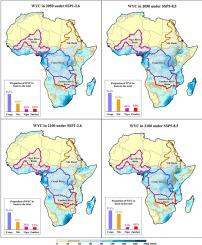当前位置:
X-MOL 学术
›
Ecol. Indic.
›
论文详情
Our official English website, www.x-mol.net, welcomes your feedback! (Note: you will need to create a separate account there.)
Variable drivers trigger future change in water yield capacity of terrestrial ecosystems in Africa: An intensification of reduction and unevenness
Ecological Indicators ( IF 6.9 ) Pub Date : 2024-03-21 , DOI: 10.1016/j.ecolind.2024.111912 Xinya Guo , Xingqi Zhang , Zhenke Zhang , Hong Yang , Lei Wan
Ecological Indicators ( IF 6.9 ) Pub Date : 2024-03-21 , DOI: 10.1016/j.ecolind.2024.111912 Xinya Guo , Xingqi Zhang , Zhenke Zhang , Hong Yang , Lei Wan

|
Predicting the water-related services of terrestrial ecosystems in a changing climate is of great significance for managing rich ecosystems in water-scarce areas. Water yield capacity (WYC), which characterizes water resource availability, was thrown into sharp focus of this study. The spatiotemporal trends of WYC and their dynamics by potential climate shifts were evaluated based on calculative WYC and climate zones for historical period (2001–2018) and future scenarios (both 2050 and 2100 under SSP1-2.6 or SSP5-8.5 scenarios). The multiple factors affecting WYC in the recent past were identified as the basis for explaining the future tendency in WYC. All analyses were conducted from the perspective of holistic continental scale and specific basin scale so as to explore the contrast between various scales. The results showed that the total WYC both in whole Africa and the four major basins (the Congo, the Nile, the Niger and the Zambezi) are projected to decrease in 2050 and 2100 compared with that in 2018, under both SSP1-2.6 or SSP5-8.5 scenarios describing future pathways with low or high greenhouse gas emissions, respectively. The areas producing WYC will be more concentrated, suggesting that the proportion of areas contributing to the top 50% of this function across Africa will drop from current 10.5% to 4.94% in 2100 under SSP5-8.5 scenario. As climate zones are likely to shift in the future, the WYC will reduce most in the areas experiencing the conversion between tropical monsoon and tropical rainforest climates. In addition, WYC was driven by precipitation, temperature, net primary productivity (NPP) and landscape pattern (connectivity and diversity), which had spatial scale effect. The results add evidence for unstable availability of water resources provided by terrestrial ecosystems in a multi-scale manner.
中文翻译:

可变驱动因素引发非洲陆地生态系统产水能力的未来变化:减少和不均匀性加剧
预测气候变化下陆地生态系统与水相关的服务对于管理缺水地区丰富的生态系统具有重要意义。表征水资源可用性的产水能力(WYC)成为本研究的重点。基于历史时期(2001-2018)和未来情景(SSP1-2.6 或 SSP5-8.5 情景下的 2050 年和 2100 年)的计算 WYC 和气候区,评估了 WYC 的时空趋势及其潜在气候变化的动态。确定近期影响WYC的多重因素,作为解释WYC未来趋势的基础。所有分析均从整体大陆尺度和具体盆地尺度的角度进行,以探讨不同尺度之间的对比。结果表明,无论是在SSP1-2.6还是SSP5下,预计2050年和2100年整个非洲和四大流域(刚果河、尼罗河、尼日尔河和赞比西河)的WYC总量将比2018年有所减少-8.5 情景分别描述温室气体排放量低或高的未来路径。产生WYC的地区将更加集中,这表明在SSP5-8.5情景下,非洲贡献前50%这一功能的地区比例将从目前的10.5%下降到2100年的4.94%。由于未来气候带可能发生变化,WYC 将在经历热带季风气候和热带雨林气候转换的地区减少大部分。此外,WYC受降水、气温、净初级生产力(NPP)和景观格局(连通性和多样性)驱动,具有空间尺度效应。研究结果进一步证明陆地生态系统以多尺度方式提供的水资源不稳定。
更新日期:2024-03-21
中文翻译:

可变驱动因素引发非洲陆地生态系统产水能力的未来变化:减少和不均匀性加剧
预测气候变化下陆地生态系统与水相关的服务对于管理缺水地区丰富的生态系统具有重要意义。表征水资源可用性的产水能力(WYC)成为本研究的重点。基于历史时期(2001-2018)和未来情景(SSP1-2.6 或 SSP5-8.5 情景下的 2050 年和 2100 年)的计算 WYC 和气候区,评估了 WYC 的时空趋势及其潜在气候变化的动态。确定近期影响WYC的多重因素,作为解释WYC未来趋势的基础。所有分析均从整体大陆尺度和具体盆地尺度的角度进行,以探讨不同尺度之间的对比。结果表明,无论是在SSP1-2.6还是SSP5下,预计2050年和2100年整个非洲和四大流域(刚果河、尼罗河、尼日尔河和赞比西河)的WYC总量将比2018年有所减少-8.5 情景分别描述温室气体排放量低或高的未来路径。产生WYC的地区将更加集中,这表明在SSP5-8.5情景下,非洲贡献前50%这一功能的地区比例将从目前的10.5%下降到2100年的4.94%。由于未来气候带可能发生变化,WYC 将在经历热带季风气候和热带雨林气候转换的地区减少大部分。此外,WYC受降水、气温、净初级生产力(NPP)和景观格局(连通性和多样性)驱动,具有空间尺度效应。研究结果进一步证明陆地生态系统以多尺度方式提供的水资源不稳定。



























 京公网安备 11010802027423号
京公网安备 11010802027423号